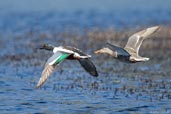(aka Anas clypeata)

Photos 1 and 2 were taken on Westray, Orkney, Scotland, photos 3 and 4 in Suffolk; photo 5 in the Yukon, Canada and photos 6 to 8 in North Uist, Scotland.







| Previous Page | Back to Index | Next Page |
| Northern Shoveler Spatula clypeata (aka Anas clypeata) |
||||
 |
The Northern Shoveler is distributed in temperate zones of Europe, Asia and North America. See the distribution
map at xeno-canto. They are found in open woodland and grassland where
there are shallow fresh-water bodies on which they can feed.
Photos 1 and 2 were taken on Westray, Orkney, Scotland, photos 3 and 4 in Suffolk; photo 5 in the Yukon, Canada and photos 6 to 8 in North Uist, Scotland. |
|||
 |
Food consists of tiny shellfish, insects and their larvae and plants including seeds. They use various feeding techniques including dabbling and diving but are notable for their surface feeding techniques where the large bill is used to sweep the surface of the water and their highly developed filtering mechanism retains plankton, etc.. | |||
 |
They are largely migratory with populations moving south in the winter but in a general shift rather than a unified movement. Thus birds that have bred in Iceland winter in Britain and birds that bred in Britain winter in France and Spain. | |||
 |
It has a very noticeable long and broad bill which gives the bird a front heavy look when swimming and flying. The breeding male, as seen in these photos, has a green head, a white breast and a bright chestnut belly and flanks. The upper forewing is pale blue and it has a green speculum with a white border at the front edge. The female, seen to the right of photos 4 and 5, looks a bit like a female Mallard but with an enormous bill. | |||
 |
||||
 |
||||
 |
||||
 |
||||
|
| If you do not see a menu on the left, you may have arrived at this page from another site. Please click Home to get to my main page. |